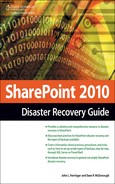If you’ve done any previous research on SharePoint disaster recovery topics, such as content recovery, backup and restore, and high availability, you’ve probably found quite a bit of information on the subject. That held true for us when we wrote the original Disaster Recovery Guide for SharePoint 2007, and it’s just as true now with SharePoint 2010. But what we also found was that much of the discussion did one of two things: either it just scratched the surface of SharePoint disaster recovery, or it covered such a narrow focus that it was only applicable in certain situations. So we set out to create a resource for SharePoint disaster recovery that comprehensively examined the ins and outs of the various technical options available to back up and restore your SharePoint environment and highlighted the concerns you need to understand to build an informed and well-rounded disaster recovery plan.
Microsoft’s SharePoint platform is a complex, diverse technical tool designed to meet a range of business needs and uses. It requires several other platforms and applications for implementation, and it can be integrated with other external lines of business applications. This diversity also applies to the numerous methods, tools, and approaches that can be used to preserve your Share-Point farm if it becomes affected by a catastrophic event. The majority of this book introduces you to those methods, tools, and approaches for backing up and restoring SharePoint. Before covering all the crucial technical aspects of preserving SharePoint with the tools Microsoft provides for it, we introduce you to the key concepts and activities necessary to develop a disaster recovery plan to implement those technical practices. Listed next are some of the main concepts this recovery guide discusses:
Learning the concepts and terminology of SharePoint disaster recovery planning
Designing and documenting a SharePoint disaster recovery plan
Testing and maintaining a SharePoint disaster recovery plan
Understanding SharePoint-specific disaster recovery concerns and best practices
Backing up and restoring the foundation of any SharePoint environment, Windows Server 2008
Understanding how high-availability technologies can aid in SharePoint disaster recovery
Discussing the role that SQL Server and its backup options play in the SharePoint disaster recovery equation
Utilizing SharePoint’s Central Administration site for backup and restore tasks
Exploring the new options that are available through PowerShell and SharePoint-specific cmdlets
Investigating the SharePoint object model and how to employ custom development to meet special backup and restore needs
Highlighting end user disaster recovery options and the administrative concerns that are tied to them
In general, this book is geared toward readers who are worried about the long-term health and viability of their SharePoint environment and the valuable business information stored in it. It’s assumed that readers are at least familiar with SharePoint as end users, and most of the technical content inside is best suited for those who have experience deploying, configuring, and administrating SharePoint. The examples, walk-throughs, and advice in this recovery guide are intended to be general and can be applied to a variety of situations and SharePoint environments.
Each chapter has relevant visual aids such as screenshots, diagrams, and example documents to guide you through the topics being discussed. You’ll also find special breakout sections to call your attention to items of note, tips and tricks, and areas of caution that we have found particularly relevant. Finally, each chapter ends with a series of review questions intended to test your understanding of what you’ve completed and help you think about some of the chapter’s key concepts. Don’t worry, though; we’re providing answers to those questions in Appendix A, “Chapter Review Q&A.” For more information on Appendix A, see the “Companion Web Site Downloads” section that follows.
In addition to the contents of this book, several additional resources are available to you on the Cengage Learning Web site at http://www.courseptr.com/downloads.
Bonus Chapter. This chapter discusses disaster recovery approaches for several common SharePoint environments and farm configurations. These disaster recovery outlines integrate a variety of the concepts and technologies discussed in this book, and they may help you begin thinking about SharePoint disaster recovery plans in your own environment(s).
Appendix A. This appendix contains the answers to the questions that are posed at the end of each chapter in this book. If you want to check your comprehension of each chapter as you read it, be sure to go online to grab the answers in this appendix.
Appendix B. This appendix is an alphabetical list of third-party backup and restore tools that are available for SharePoint 2010 at the time this book was originally published. As much as we would have liked to cover each of these tools in the same depth we devoted to out-of-the-box options from Microsoft, it just wasn’t possible given timelines and space constraints we were already up against. But that doesn’t mean these tools are unworthy of mention, so in this appendix you’ll find a quick synopsis of each tool’s attributes as provided by their manufacturer and direction on where you can find out more.
